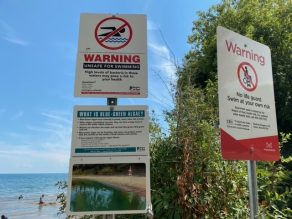What’s that Smell? It Could Be Blue-Green Algae
Environment | September 1, 2022
This time of year, blue-green algae can become an uninvited guest on your visit to the lake, river or waterside park. Blue-green algae blooms appear in the late summer and early fall and can be harmful to your health, the environment and our source of local drinking water. It’s important to know how to spot, prevent and report blue-green algae for your safety and the health of the environment.
What is blue-green algae?
Blue-green algae are a type of bacteria that can naturally occur in ponds, lakes and streams making the water often look blueish-green or sometimes olive-green or red. It can also create a rotting garbage smell. Although not normally visible in the water, when conditions are favourable, the algae can form a large mass or floating layer (scum) called a bloom. These blooms occur most often in the late summer and early fall, where the water is shallow, slow moving, warm and full of nutrients such as nitrogen and phosphorus. These nutrients can get into the water from fertilizer and contaminated stormwater runoff.
What to do if you see blue-green algae
While algae naturally occur and provide food and habitat for native species, blue-green algae can produce toxins which can be poisonous to humans, animals and aquatic wildlife. Toxins spread through contact, digestion and inhalation and in humans this can lead to diarrhea, nausea and breathing issues. If you spot a blue-green algae bloom – assume that toxins are present.
- Check for swimming and fishing advisories before visiting lakes and rivers. Avoid using, drinking, bathing, fishing or swimming in water when blue-green algae are present.
- Watch for dead fish and other dead animals along the shoreline. If you see an abundance of dead fish along the shore line, contact the Ministry of Natural Resources and Forestry. For questions related to dead animal sightings in Mississauga, contact Animal Services at 905-896-5858.
- Keep an eye on your pets – don’t allow them to drink from or access the water or ingest any dead animals. The algae can also stick to your pet’s fur, which they can ingest when they clean themselves.
- Call the Spills Action Centre (1-800-268-6060) to report it.
The City of Mississauga co-ordinates with Peel Public Health who monitor water quality at three of Mississauga’s beaches: Jack Darling Memorial Park, Lakefront Promenade and Richard’s Memorial Park. Signage gets posted at these beaches if bacteria levels in the water are high enough to pose a health risk.

Preventing blue-green algae
When debris and nutrient waste, like animal waste and fertilizer, drain from your property and flow into the catchbasins on your street, they make their way into our creeks and rivers. These pollutants end up in Lake Ontario – Mississauga’s largest source of drinking water.
Reduce the risk of blue-green algae through prevention:
- Use phosphate-free detergents and cleaning products and consider taking your car to a commercial car wash instead of washing it in your driveway. When you wash your car in your driveway, soaps and detergents can flow into stormwater catchbasins on the roadway.
- Apply any commercial fertilizer products strictly according to the manufacturer’s instructions and prevent any excess fertilizer from spreading onto the roadway or sidewalks where it can wash into stormwater catchbasins.
- Always pick up pet waste and dispose of it properly. Pet waste contains high nutrient levels, bacteria and viruses that make it a serious threat to water quality.
To learn more about the City’s stormwater system and how to prevent stormwater pollution, visit mississauga.ca/stormwater and follow @saugastormwater on Instagram.
Tags
Media Contact:
City of Mississauga Media Relations
media@mississauga.ca
905-615-3200, ext. 5232
TTY: 905-896-5151